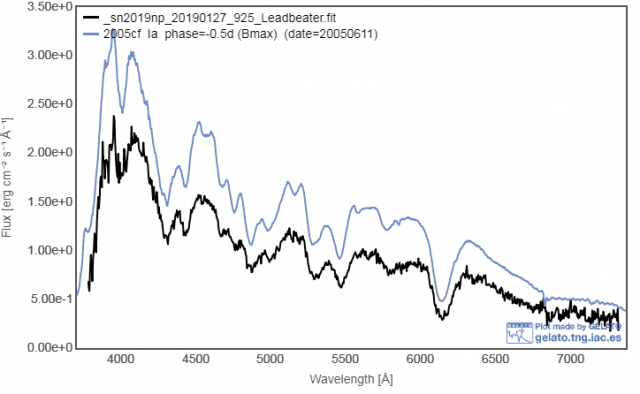› Forums › Spectroscopy › potentially bright supernova in NGC3254
- This topic has 7 replies, 4 voices, and was last updated 6 years, 10 months ago by
 David Swan.
David Swan.
-
AuthorPosts
-
10 January 2019 at 8:30 pm #574232
 Robin LeadbeaterParticipantA supernova has been reported in NGC3254It is currently too faint for most amateurs at mag 18 (right at my limit with the ALPY200) but according to the published spectrum it is a type Ia, possibly caught a remarkable 2 weeks before maximum so based on the distance to NGC3254 and that from the spectrum there does not seem to be much redenning, it could reach ~mag 13.One to watch!Robin19 January 2019 at 4:36 pm #580565
Robin LeadbeaterParticipantA supernova has been reported in NGC3254It is currently too faint for most amateurs at mag 18 (right at my limit with the ALPY200) but according to the published spectrum it is a type Ia, possibly caught a remarkable 2 weeks before maximum so based on the distance to NGC3254 and that from the spectrum there does not seem to be much redenning, it could reach ~mag 13.One to watch!Robin19 January 2019 at 4:36 pm #580565 David SwanParticipant
David SwanParticipantK Itagaki’s latest image on David Bishop’s site puts the SN brightness at around 13.6 (clear filter, presumably V mag zeropoint).
Unfortunately there’s been quite poor weather in NE England recently – with just snatches of clear sky – so I haven’t been able to get at this object.
19 January 2019 at 5:40 pm #580566 Dr Paul LeylandParticipant
Dr Paul LeylandParticipantIt’s happened 4 weeks too early for me. Not back in La Palma until mid-February, where I can reach mag 20 or better with around an hour’s exposure. Can’t even reach mag 8 from here.
Oh well.
19 January 2019 at 8:39 pm #580567 Robin LeadbeaterParticipant
Robin LeadbeaterParticipantHi Paul,
It has not maxed out yet so if it follows the normal Ia light curve will likely be around mag 16 in a month’s time so still an easy imaging target.
Note my original comment on mag 18 being out of range for amateurs referred specifically to spectroscopy, not imaging. With my ALPY 200 the target has to be about 6.5 mags brighter for spectroscopy than for a conventional photometry image. The big advantage with slit spectroscopy though is most of the sky background is kept out by the slit so you can get away with much higher levels of light pollution. My limiting spectroscopic magnitude is ~17.5 which corresponds to mag 24 for photometry. I would need much darker skies to do photometry that deep in a conventional image though.
Cheers
Robin
20 January 2019 at 11:46 am #580570 Robin LeadbeaterParticipant
Robin LeadbeaterParticipantPeter Somogyi has now posted an amateur spectrum on the ARAS forum using an ALPY 600
http://www.spectro-aras.com/forum/viewtopic.php?f=38&t=2205#p12098
He has also posted a spectrum of sn2018hna which I classified as a type II when discovered back in October 2018 at mag 16 but strangely has been rising steadily since it was discovered and is currently mag 13.7
http://www.spectro-aras.com/forum/viewtopic.php?f=38&t=2214
The differences in the spectrum between the two (Ia and IIP) are very obvious
Cheers
Robin
28 January 2019 at 11:04 pm #580607 Robin LeadbeaterParticipant
Robin LeadbeaterParticipantA spectrum from last night with the ALPY 600 compared with a best match type Ia near maximum from GELATO
 29 January 2019 at 9:21 am #580608
29 January 2019 at 9:21 am #580608 Andrew RobertsonParticipant
Andrew RobertsonParticipantI did get a visual sighting last night in my 12″ Mewlon but skies not the best, a bit claggy, NELM mag 5 to mag 5.5. Comparing to field stars I estimated it to be about mag 13.3. Comparison stars:
Brighter than GSC 01976-0429 mag 14.1
Fainter than GSC 01976-0815 mag 12.2
About the same as GSC 01976-0125 mag 13.3
Andrew
7 February 2019 at 10:33 pm #580651 David SwanParticipant
David SwanParticipantFor those who are interested and haven’t visually observed or imaged this yet, this transient is still quite bright and nicely placed in Leo Minor for evening obs.
-
AuthorPosts
- You must be logged in to reply to this topic.
